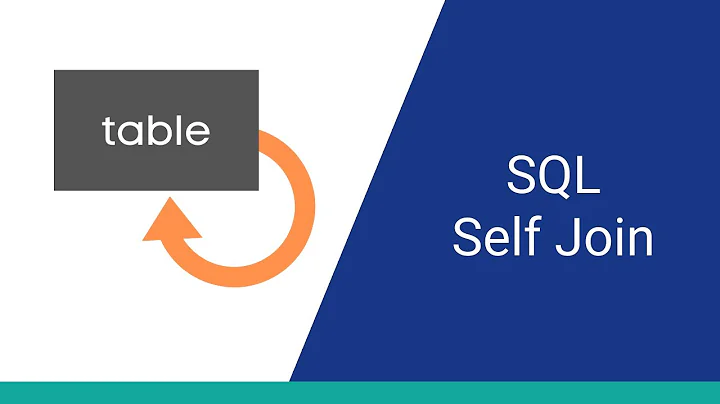Simplest way to do a recursive self-join?
Solution 1
WITH q AS
(
SELECT *
FROM mytable
WHERE ParentID IS NULL -- this condition defines the ultimate ancestors in your chain, change it as appropriate
UNION ALL
SELECT m.*
FROM mytable m
JOIN q
ON m.parentID = q.PersonID
)
SELECT *
FROM q
By adding the ordering condition, you can preserve the tree order:
WITH q AS
(
SELECT m.*, CAST(ROW_NUMBER() OVER (ORDER BY m.PersonId) AS VARCHAR(MAX)) COLLATE Latin1_General_BIN AS bc
FROM mytable m
WHERE ParentID IS NULL
UNION ALL
SELECT m.*, q.bc + '.' + CAST(ROW_NUMBER() OVER (PARTITION BY m.ParentID ORDER BY m.PersonID) AS VARCHAR(MAX)) COLLATE Latin1_General_BIN
FROM mytable m
JOIN q
ON m.parentID = q.PersonID
)
SELECT *
FROM q
ORDER BY
bc
By changing the ORDER BY condition you can change the ordering of the siblings.
Solution 2
Using CTEs you can do it this way
DECLARE @Table TABLE(
PersonID INT,
Initials VARCHAR(20),
ParentID INT
)
INSERT INTO @Table SELECT 1,'CJ',NULL
INSERT INTO @Table SELECT 2,'EB',1
INSERT INTO @Table SELECT 3,'MB',1
INSERT INTO @Table SELECT 4,'SW',2
INSERT INTO @Table SELECT 5,'YT',NULL
INSERT INTO @Table SELECT 6,'IS',5
DECLARE @PersonID INT
SELECT @PersonID = 1
;WITH Selects AS (
SELECT *
FROM @Table
WHERE PersonID = @PersonID
UNION ALL
SELECT t.*
FROM @Table t INNER JOIN
Selects s ON t.ParentID = s.PersonID
)
SELECT *
FROm Selects
Solution 3
The Quassnoi query with a change for large table. Parents with more childs then 10: Formating as str(5) the row_number()
WITH q AS
(
SELECT m.*, CAST(str(ROW_NUMBER() OVER (ORDER BY m.ordernum),5) AS VARCHAR(MAX)) COLLATE Latin1_General_BIN AS bc
FROM #t m
WHERE ParentID =0
UNION ALL
SELECT m.*, q.bc + '.' + str(ROW_NUMBER() OVER (PARTITION BY m.ParentID ORDER BY m.ordernum),5) COLLATE Latin1_General_BIN
FROM #t m
JOIN q
ON m.parentID = q.DBID
)
SELECT *
FROM q
ORDER BY
bc
Solution 4
Check following to help the understand the concept of CTE recursion
DECLARE
@startDate DATETIME,
@endDate DATETIME
SET @startDate = '11/10/2011'
SET @endDate = '03/25/2012'
; WITH CTE AS (
SELECT
YEAR(@startDate) AS 'yr',
MONTH(@startDate) AS 'mm',
DATENAME(mm, @startDate) AS 'mon',
DATEPART(d,@startDate) AS 'dd',
@startDate 'new_date'
UNION ALL
SELECT
YEAR(new_date) AS 'yr',
MONTH(new_date) AS 'mm',
DATENAME(mm, new_date) AS 'mon',
DATEPART(d,@startDate) AS 'dd',
DATEADD(d,1,new_date) 'new_date'
FROM CTE
WHERE new_date < @endDate
)
SELECT yr AS 'Year', mon AS 'Month', count(dd) AS 'Days'
FROM CTE
GROUP BY mon, yr, mm
ORDER BY yr, mm
OPTION (MAXRECURSION 1000)
Solution 5
SQL 2005 or later, CTEs are the standard way to go as per the examples shown.
SQL 2000, you can do it using UDFs -
CREATE FUNCTION udfPersonAndChildren
(
@PersonID int
)
RETURNS @t TABLE (personid int, initials nchar(10), parentid int null)
AS
begin
insert into @t
select * from people p
where personID=@PersonID
while @@rowcount > 0
begin
insert into @t
select p.*
from people p
inner join @t o on p.parentid=o.personid
left join @t o2 on p.personid=o2.personid
where o2.personid is null
end
return
end
(which will work in 2005, it's just not the standard way of doing it. That said, if you find that the easier way to work, run with it)
If you really need to do this in SQL7, you can do roughly the above in a sproc but couldn't select from it - SQL7 doesn't support UDFs.
Related videos on Youtube
Chris
Updated on July 08, 2022Comments
-
Chris almost 2 years
What is the simplest way of doing a recursive self-join in SQL Server? I have a table like this:
PersonID | Initials | ParentID 1 CJ NULL 2 EB 1 3 MB 1 4 SW 2 5 YT NULL 6 IS 5And I want to be able to get the records only related to a hierarchy starting with a specific person. So If I requested CJ's hierarchy by PersonID=1 I would get:
PersonID | Initials | ParentID 1 CJ NULL 2 EB 1 3 MB 1 4 SW 2And for EB's I'd get:
PersonID | Initials | ParentID 2 EB 1 4 SW 2I'm a bit stuck on this can can't think how to do it apart from a fixed-depth response based on a bunch of joins. This would do as it happens because we won't have many levels but I would like to do it properly.
Thanks! Chris.
-
 boydc7 over 14 yearsWhich version of SQL Server are you using? i.e. Sql 2000, 2005, 2008?
boydc7 over 14 yearsWhich version of SQL Server are you using? i.e. Sql 2000, 2005, 2008? -
OMG Ponies over 14 yearsSO questions regarding recursive queries: stackoverflow.com/search?q=sql-server+recursive
-
-
Can Sahin over 14 years+1, except that Chris would need
PersonID = theIdYouAreLookingForinstead ofParentID IS NULL. -
 Kishore Kumar over 11 yearsI have posted a new question on SO, stackoverflow.com/questions/13535003/…
Kishore Kumar over 11 yearsI have posted a new question on SO, stackoverflow.com/questions/13535003/… -
Oli B over 10 yearsGood complete answer with the important WHERE PersonID = @PersonID
-
Quassnoi over 9 years@Aaroninus: The parent node is defined by the topmost (anchor) query in the
WITHclause. If you need specifics, please create a fiddle on sqlfiddle.com and post the link here. -
Josh McGee over 3 yearsThis query doesn't work for me until I change the first line to "WITH RECURSIVE q AS", for reference I'm using "10.3.23-MariaDB-0+deb10u1"
-
Quassnoi over 3 years@JoshMcGee: why did you expect an SQL Server query work on MariaDB without changes?
-
Josh McGee over 3 yearsjust posting for reference in case someone else using MariaDB has the same problem








